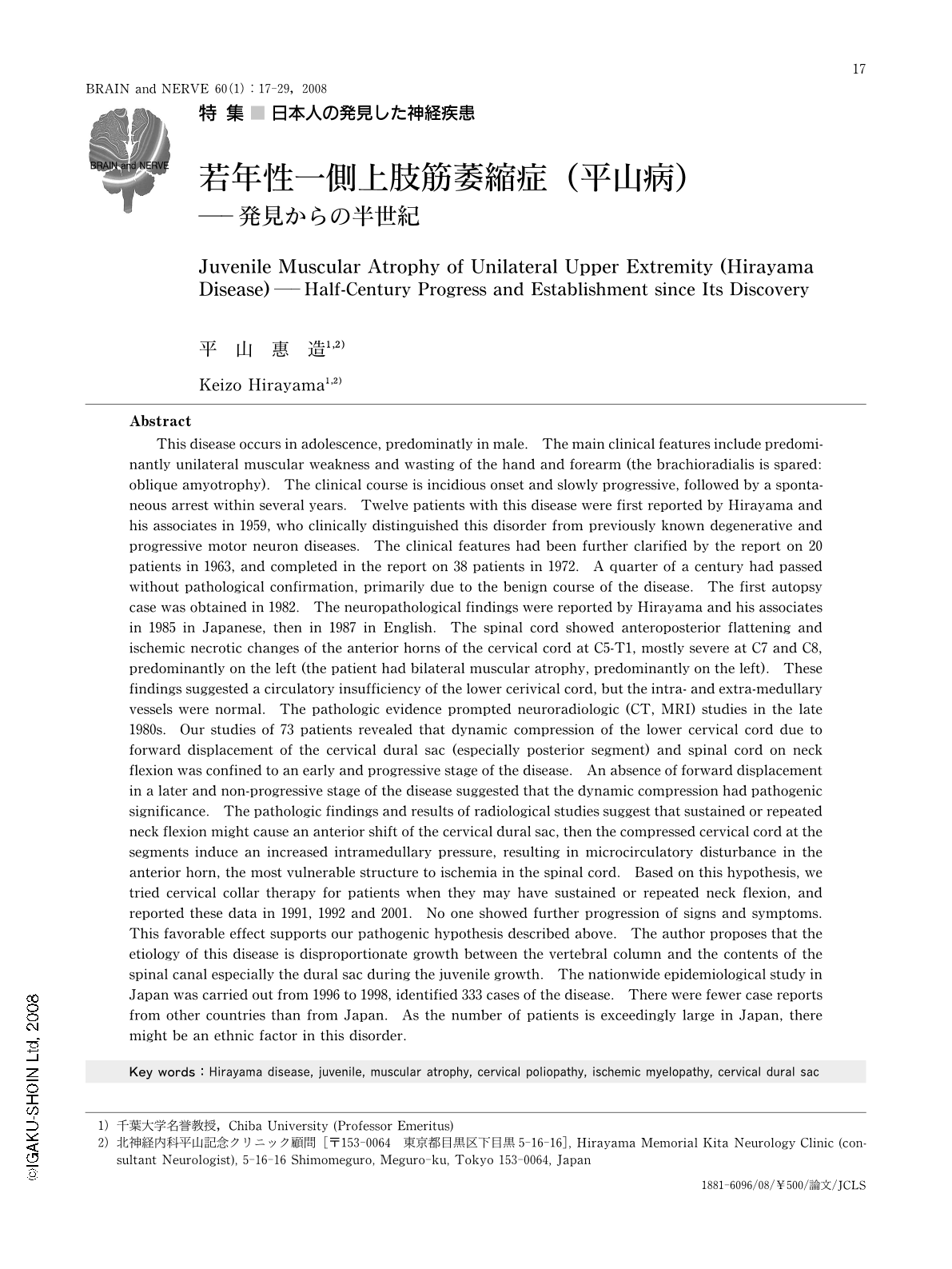Japanese
English
- 有料閲覧
- Abstract 文献概要
- 1ページ目 Look Inside
- 参考文献 Reference
Ⅰ.発見の端緒―臨床的独立
本症発見の契機は半世紀ほど前になる。当時,筆者は冲中重雄教授(東京大学第三内科)から学位研究に筋萎縮性側索硬化症(amyotrophic lateral sclerosis: ALS)と脊髄性進行性筋萎縮症(spinal progressive muscular atrophy: SPMA)が課題として与えられた。まず,これら疾患の本邦での実態を知る目的から,冲中内科の入院・外来患者の病歴調査を始めた。診断のための確かな臨床像を求めて内外の神経学教科書類を渉猟したが,その具体像を絞りきれなかった。そこで両疾患の原典というべきJM Charcotの講義録1)にさかのぼったところ,臨床-病理像が具体的に細密に記述されていた。これを元に前記冲中内科症例の病歴を一つひとつ検証すると,ALSにもSPMAにも該当しないものが混在して,その中に特異な臨床的特徴を有する十余名の一群があることに気付いた。すなわち,若年の男性で,筋萎縮が一側の上肢の遠位に限られており,あまり進行性ではない,などである。これらの患者に来院してもらい,その臨床所見をいっそう明確にすることができた。
次の段階として,この特異な臨床像を呈する疾患(症例)が過去に報告されていないかを確認する必要があった。この文献検索は1900年以前にまでさかのぼる厖大な作業であった。唯一参考文献としてMarie et Foixの論文2)を見出したが,他にはしかるべき報告がないことから,本症の臨床的独立性を確信し,1959年に学会に報告3)し,原著論文4)にまとめた。この経緯は別報に詳述した5,6)。また本症の全貌を要約したものや7-10)詳述した総説があるが11-14),本稿はそれらにさらに肉付けしたものである。
Abstract
This disease occurs in adolescence, predominatly in male. The main clinical features include predominantly unilateral muscular weakness and wasting of the hand and forearm (the brachioradialis is spared: oblique amyotrophy). The clinical course is incidious onset and slowly progressive, followed by a spontaneous arrest within several years. Twelve patients with this disease were first reported by Hirayama and his associates in 1959, who clinically distinguished this disorder from previously known degenerative and progressive motor neuron diseases. The clinical features had been further clarified by the report on 20 patients in 1963, and completed in the report on 38 patients in 1972. A quarter of a century had passed without pathological confirmation, primarily due to the benign course of the disease. The first autopsy case was obtained in 1982. The neuropathological findings were reported by Hirayama and his associates in 1985 in Japanese, then in 1987 in English. The spinal cord showed anteroposterior flattening and ischemic necrotic changes of the anterior horns of the cervical cord at C5-T1, mostly severe at C7 and C8, predominantly on the left (the patient had bilateral muscular atrophy, predominantly on the left). These findings suggested a circulatory insufficiency of the lower cerivical cord, but the intra- and extra-medullary vessels were normal. The pathologic evidence prompted neuroradiologic (CT, MRI) studies in the late 1980s. Our studies of 73 patients revealed that dynamic compression of the lower cervical cord due to forward displacement of the cervical dural sac (especially posterior segment) and spinal cord on neck flexion was confined to an early and progressive stage of the disease. An absence of forward displacement in a later and non-progressive stage of the disease suggested that the dynamic compression had pathogenic significance. The pathologic findings and results of radiological studies suggest that sustained or repeated neck flexion might cause an anterior shift of the cervical dural sac, then the compressed cervical cord at the segments induce an increased intramedullary pressure, resulting in microcirculatory disturbance in the anterior horn, the most vulnerable structure to ischemia in the spinal cord. Based on this hypothesis, we tried cervical collar therapy for patients when they may have sustained or repeated neck flexion, and reported these data in 1991, 1992 and 2001. No one showed further progression of signs and symptoms. This favorable effect supports our pathogenic hypothesis described above. The author proposes that the etiology of this disease is disproportionate growth between the vertebral column and the contents of the spinal canal especially the dural sac during the juvenile growth. The nationwide epidemiological study in Japan was carried out from 1996 to 1998, identified 333 cases of the disease. There were fewer case reports from other countries than from Japan. As the number of patients is exceedingly large in Japan, there might be an ethnic factor in this disorder.

Copyright © 2008, Igaku-Shoin Ltd. All rights reserved.


